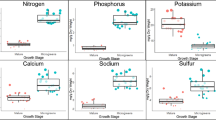Abstract
Tender and mature leaflets and leaves of Diplazium sammatii (`Nyama idim'), were separately investigated for their nutritional and antinutritional properties. Results showed little difference in proximate nutritional contents between tender and mature leaves, except for crude fat, which was present in levels 1.5 times higher in younger than in older leaves. Crude fiber levels were low. Zinc (Zn) and copper (Cu) were higher in younger leaves (6.8 and 3.5 mg/100 g dry matter, respectively, compared to 4.5 and 2.5 mg/100 g dry matter, respectively in older leaves). Older leaves contained higher levels of iron (Fe): 6.7 mg/100 g dry matter, in comparison to 4.3mg/100 g dry matter, in young leaves. Oxalate levels were slightly higher in younger than older leaves. However, the reverse was true for tannin content. Both antinutritional compounds were present in levels which shouldbe safe.
Similar content being viewed by others
References
Alston AHG (1959) The Ferns and Fern-Allies of West Tropical Africa Crown Agents for oversea Governments and Administrations. London: pp 64-65.
Haynes JD (1975) Botany: An Introductory Survey of the Plant Kingdom. New York: John Wiley and Sons, pp 350-364.
AOAC (1984) Official Methods of Analysis: Association of Official Analytical Chemists, Williams CS (ed), 14th edn. Washington DC: AOAC Inc.
Dye WB (1956) Studies on halogeton glomeratus. Weeds 4: 55-58.
Harbone JB (1973) Phytochemical Methods. London: Chapman and Hills, pp 143-144.
Burns RF (1971) Methods of estimation of tannin in the grain sorghum. Agron J 63: 511-515.
Oyenuga VA (1968) Nigerian Foods and Feeding Stuffs: Their Chemistry and Nutritive Values. Nigeria: Ibadan University Press.
Ifon ET, Bassir O (1979) The nutritive value of some Nig. Leafy green vegetables, Part 2: Distribution of protein, carbohydrates, fats, etc. Food Chem 5: 231-235.
Eyo EJ, Momme E, Abel HO (1983) Chemical composition and aimno acid contents of Gnetum africanum, Heinsa crinita and Piper guineensis. Nig J Nutri Sci 4: 57-62.
Ifon ET (1977) Nutrient composition of some Nigerian leafy green vegetables and the physiological availability of their iron contents, PhD Thesis, Biochemistry Department, University of Ibadan, Ibadan, Nigeria pp 20-120.
Isong EU, Adewusi SAR, Nkanga EU, Umoh EE, Offiong EE (1998) Nutritional and phytogeriatological africanum ('Afang'). Food Chem 34: 17-22.
Trowell IH, Burkitt D (1986) Physiological role of dietary fibre: A ten year review. ASDC J Dent Child 53: 444-447.
Etuk EUI, Bassey MN, Ekpenyong DC, Idiong IO (1997) Quality assessment of two rural infant dietary vegetables. Ind J Nutr Dietet 34: 5-9.
Agostoni C, Riva E, Giovannini M (1995) Dietary fibre increasing foods of young children. Pediatrics 96: 1002-1004.
Williams CL, Bollela M (1995) Is a high fibre diet safe for children? Pediatrics 96: 1014-1019.
Bassir O, Fafunso M (1975) Variation in the protein, carbohydrate lipid and ash contents of six tropical vegetables. Plant Foods Manual 1: 209-216.
Munro A, Bassir O (1969) Oxalates in Nigerian vegetables. West Afric J Biol Appl Chem 12: 14-17.
Robinson AH, Lawler WE (1977) Normal and Therapeutic Nutrition. New York.
Oke OL (1969) Role of hydrocyanic acid in nutrition. World Rev Nutr Dietet 11: 170-174.
Author information
Authors and Affiliations
Rights and permissions
About this article
Cite this article
Bassey, M., Etuk, E., Ibe, M. et al. Diplazium sammatii: Athyraceae (`Nyama Idim'): Age-related nutritional and antinutritional analysis. Plant Foods Hum Nutr 56, 7–12 (2001). https://doi.org/10.1023/A:1008185513685
Issue Date:
DOI: https://doi.org/10.1023/A:1008185513685



